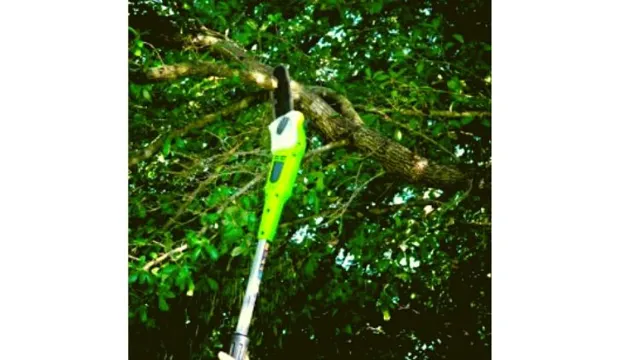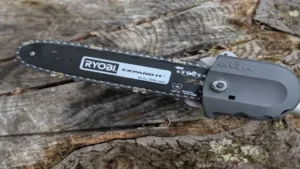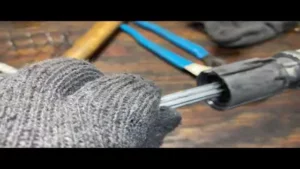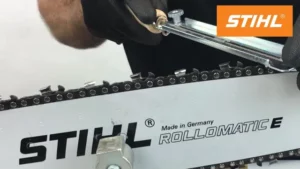Welcome to our latest blog post, where we’ll be delving into the world of pole saws and answering one of the most pressing questions people have- how thick can a pole saw cut? Pole saws are an incredibly useful tool to make your garden tasks quicker and easier. However, knowing the cutting capacity of your pole saw is crucial to getting the job done safely and efficiently. In this article, we’ll explore the factors that determine how thick a pole saw can cut through materials and provide you with some useful tips on how to maximize their cutting capacity.
So, sit back and relax as we take a deep dive into this fantastic gardening tool!
Understanding Pole Saw Cuts
When it comes to using a pole saw, one of the most common questions is how thick a pole saw can cut. The answer depends on a variety of factors, including the type of blade on your pole saw and the power of the motor. Generally speaking, most pole saws can handle branches and limbs up to 6 inches in diameter without too much trouble.
However, if you’re dealing with larger trees or branches, you may need a more heavy-duty saw to make clean, efficient cuts. Keep in mind that using a pole saw to cut branches that are too thick can put a strain on the saw and pose safety risks, so it’s important to choose the right tool for the job. By understanding the limitations of your pole saw and taking the time to select the right blade and power level, you can achieve effective and safe results every time you use it.
Types of Pole Saws
Pole saws are handy tools that help gardeners and arborists prune and trim trees from a safe distance. Understanding pole saw cuts is crucial to achieving desired results and preventing injuries. There are two primary types of pole saw cuts: the overhand cut and the underhand cut.
The overhand cut involves cutting down from the top of the branch, while the underhand cut requires cutting up from beneath the branch. The overhand cut allows for more control and precision, but it’s more challenging to perform. The underhand cut is easier to execute and more comfortable, but it might damage the bark, leaving the tree exposed to diseases and pests.
The choice of cut depends on the branch’s size and location and the task at hand. Knowing the differences between the two types of cuts and when to use them can help gardeners and arborists work efficiently and safely with their pole saws.
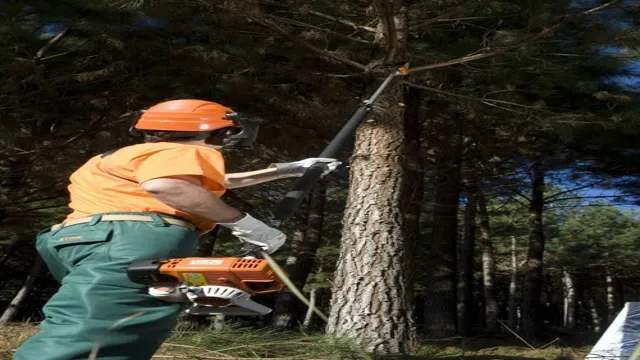
Blade Lengths and Thicknesses
Pole saws are a great tool for trimming and pruning trees, but not all cuts are created equal. Understanding blade lengths and thicknesses can help you create the best cuts and achieve the results you want. A longer blade length allows you to reach higher branches, while a shorter blade length can give you more control for precise cuts.
Blade thickness also plays a role, with thicker blades providing more durability and strength for tougher cuts. Burstiness can affect your cuts, as a dense section of branches might require a thicker blade to prevent bending or breaking. On the other hand, a less compact area might only need a thinner blade for a clean, smooth cut.
Understanding these factors can help you approach each cut with confidence and precision, resulting in a healthier and more visually pleasing tree.
Material of the Blade
When it comes to pole saw cuts, one of the most important factors to consider is the material of the blade. The blade is the heart of the saw, and the type of material it’s made of can greatly impact its effectiveness in cutting through branches and limbs. The most common materials used for pole saw blades are steel and carbon, with each having its own unique characteristics.
Steel blades are known for their durability and resilience, making them ideal for heavy-duty cutting jobs. Carbon blades, on the other hand, are much lighter and more flexible, making them better suited for precision cuts and pruning tasks. Ultimately, the material you choose for your pole saw blade will depend on the specific job you need it for, as well as your personal preferences and budget.
To ensure the best results, it’s important to invest in a high-quality blade that’s both sharp and strong, as this will help you make clean and precise cuts every time.
Factors that Affect Pole Saw Cuts
If you’re wondering how thick can a pole saw cut, there are several factors to consider that can affect its cutting capacity. First and foremost, the type of blade attached to the pole saw can determine how deep it can cut. A longer blade can also enable it to cut thicker branches.
Unfortunately, the motor power of your pole saw also plays a crucial role in its cutting capacity. A powerful motor will allow the pole saw to cut through thicker and more challenging materials with ease. Additionally, the size of the material being cut should be taken into account.
A pole saw can cut thicker branches if the diameter of the material is within its cutting capacity. However, if the material is too large, you might need a larger or more robust machine to tackle the task effectively. Finally, if the blade’s sharpness is declining, it can significantly affect the cutting capacity, making it difficult for you to cut even the most straightforward materials using your pole saw.
By considering all of these factors, you can determine the thickest branch size your pole saw can cut and ensure that you get the job done as safely as possible.
Type of Wood
When it comes to pole saw cuts, the type of wood being cut is a major factor that affects the outcome. Hardwoods like oak and maple require more effort and take longer to cut compared to softer woods like pine or cedar. This is because the density of the wood affects the efficiency of the pole saw blade.
Softwood is typically easier to cut through, but it also tends to be more brittle, which can cause it to splinter or crack. On the other hand, hardwoods are generally stronger and more durable, but they require more power to get through them. So, when choosing a pole saw, it’s important to consider the type of wood you’ll be cutting and ensure that the tool you select is appropriate for the job.
A pole saw that’s suitable for cutting softwood may not be powerful enough to cut hardwood effectively. Ultimately, the type of wood being cut plays a significant role in determining the success of the cut, so it’s important to choose the right tool based on the wood you’ll be cutting.
The Age of Wood
Pole Saw Cuts When it comes to using a pole saw for your gardening or landscaping needs, there are several factors to consider in order to achieve the best possible cuts. First and foremost is the type of saw blade that you choose. Different blades are designed for different types of cuts such as fine pruning or heavy-duty trimming.
The length of the blade also matters, with longer blades generally being better for reaching higher branches. Other important factors that can affect your cuts include the thickness and density of the wood you are cutting, as well as the angle at which you make your cut. It’s important to take your time and make precise cuts in order to avoid damaging the tree or plant you are working on.
By considering all of these factors, you can ensure that your pole saw cuts are efficient, effective, and leave your landscaping looking its best.
Diameter of the Wood
If you’re using a pole saw to prune trees or cut down branches, one of the most important factors to consider is the diameter of the wood you’ll be cutting. Pole saws are designed to handle different sizes of wood, and attempting to cut branches that are too thick can damage the saw or cause injury. The size of the blade, the motor power, and the overall construction of the saw all play a role in determining the maximum diameter of wood that the saw can handle.
Additionally, the sharpness of the blade and the cutting angle will also affect how easily the saw can make cuts. To ensure the most efficient and safe use of your pole saw, it’s important to choose a saw that’s appropriate for the size of wood you’ll be working with and to maintain the saw properly over time. When it comes to pruning trees or cutting down branches, choosing the right tool for the job is essential for achieving the best results.
Maximum Pole Saw Cut Thickness
If you’re wondering how thick a pole saw can cut, the answer is it depends on the saw’s bar length and motor power. Generally, a pole saw can cut branches up to six inches in diameter, but this may vary based on the brand and model of the tool. If you need to cut thicker branches, it’s best to invest in a more powerful saw with a longer bar length.
Keep in mind that thicker branches may require more effort and time to cut through, so always approach the task with caution and make sure to wear safety gear. When selecting a pole saw, make sure to read the manufacturer’s recommendations and follow them to ensure safe and efficient use of the tool. With the right pole saw and techniques, you can effortlessly and safely trim the branches that are otherwise hard to reach.
Brand Comparison
When it comes to choosing the right pole saw for your yard work, one of the most important considerations is the maximum cut thickness each brand can handle. The most popular brands on the market, such as Greenworks, Worx, and Sun Joe, offer different options that can cut varying thicknesses of branches and limbs. For example, Greenworks offers a 10-inch pole saw that can cut through branches up to 6 inches thick, while Worx’s 8-inch pole saw is capable of cutting branches up to 4 inches thick.
Sun Joe offers a 10-inch pole saw that can handle branches up to 5 inches thick, making it the most powerful of the three brands mentioned. Ultimately, the decision between these brands will come down to the specific needs of your yard and the thickness of the branches you most commonly need to cut.
By considering the maximum cut thickness capabilities of each brand, you can choose the pole saw that is best suited for your needs and get your yard work done efficiently and effectively.
Safety Precautions When Using Pole Saws
When it comes to using pole saws, it’s important to know the maximum thickness they can cut through safely. Most pole saws are designed to cut through branches up to 6 inches in diameter. However, some heavy-duty models may be able to handle thicker branches.
It’s essential to check the manufacturer’s recommendations before attempting to cut through larger branches. Attempting to cut through a branch that’s too thick can cause the saw to bind or kick back, posing a serious safety hazard. Additionally, it’s crucial to always wear protective gear, such as eye and ear protection and gloves, when operating a pole saw.
Keep the saw blade sharp, and never use the saw while standing on a ladder. By following these safety precautions, you can use a pole saw comfortably and safely, without putting yourself at risk of injury.
Conclusion
In summary, the thickness that a pole saw can cut depends on numerous factors such as the length and type of blade, the power of the motor, and the operator’s skill. However, while pole saws can handle various thicknesses, as the old adage goes, it’s not about the thickness of the wood, it’s how you use the saw. So, whether you’re tackling a mammoth tree trunk or a tiny twig, remember to always prioritize safety and technique for a successful and satisfying cut.
“
FAQs
What is the maximum thickness that a pole saw can cut through?
The maximum thickness a pole saw can cut through depends on the blade length and motor strength, but typically ranges between 6 to 12 inches.
Can a pole saw cut through thicker branches than a regular chainsaw?
No, typically pole saws have shorter blades and less powerful motors than regular chainsaws, so they cannot cut through thicker branches.
How do I choose the right pole saw for my needs?
Consider the blade length, motor strength, weight, and reach of the pole saw to determine which one will work best for your specific needs.
Can I use a pole saw to prune fruit trees?
Yes, a pole saw can be used to prune fruit trees, but make sure to choose one with a smaller blade for precision cuts.
What safety precautions should I take when using a pole saw?
Always wear appropriate safety gear, such as a hard hat and eye protection, and make sure the pole saw is securely fastened before use. Avoid using it near power lines and always keep both hands on the saw.
Should I sharpen the blade of my pole saw?
Yes, it is important to sharpen the blade of your pole saw regularly to ensure clean and efficient cuts.
Can I use a pole saw to trim hedges?
Yes, a pole saw with a longer reach can be used to trim high hedges, but it may be easier and more efficient to use a hedge trimmer instead.
